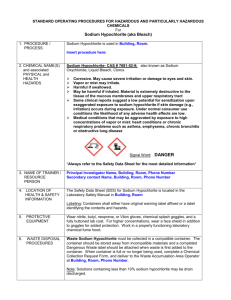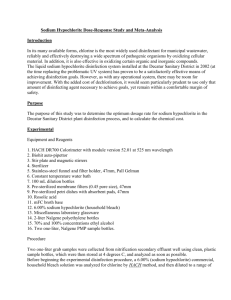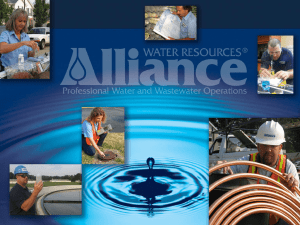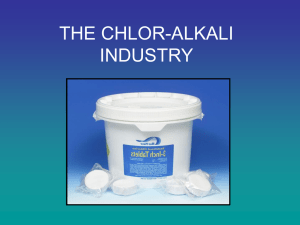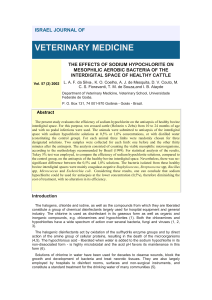Sodium hypochlorite
advertisement
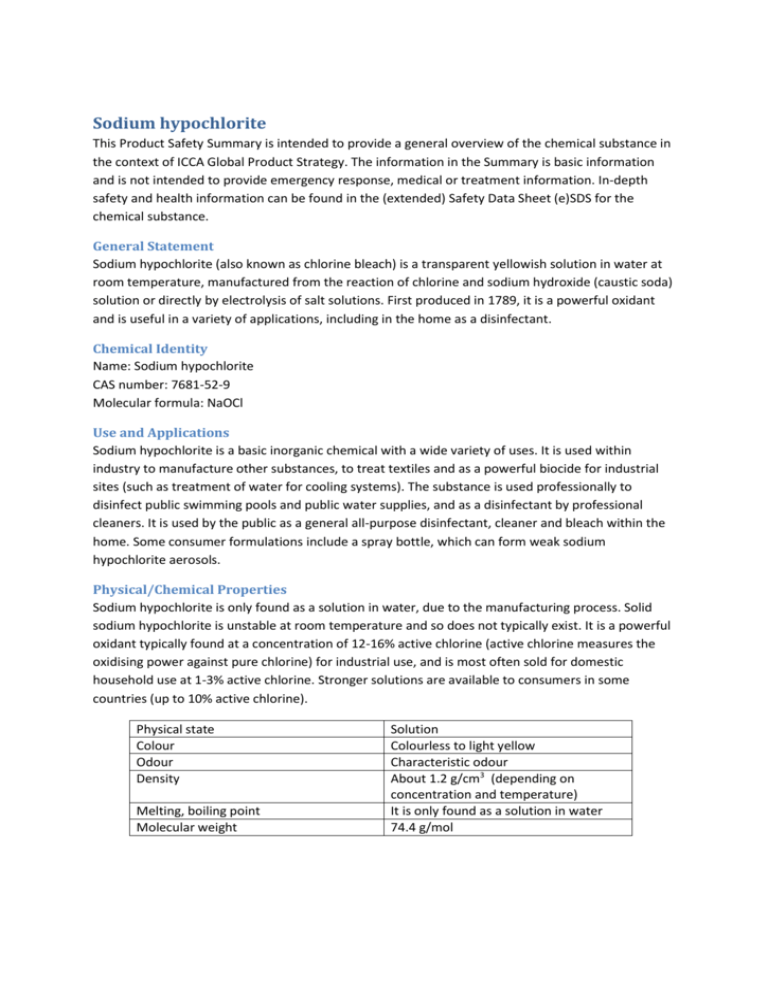
Sodium hypochlorite This Product Safety Summary is intended to provide a general overview of the chemical substance in the context of ICCA Global Product Strategy. The information in the Summary is basic information and is not intended to provide emergency response, medical or treatment information. In-depth safety and health information can be found in the (extended) Safety Data Sheet (e)SDS for the chemical substance. General Statement Sodium hypochlorite (also known as chlorine bleach) is a transparent yellowish solution in water at room temperature, manufactured from the reaction of chlorine and sodium hydroxide (caustic soda) solution or directly by electrolysis of salt solutions. First produced in 1789, it is a powerful oxidant and is useful in a variety of applications, including in the home as a disinfectant. Chemical Identity Name: Sodium hypochlorite CAS number: 7681-52-9 Molecular formula: NaOCl Use and Applications Sodium hypochlorite is a basic inorganic chemical with a wide variety of uses. It is used within industry to manufacture other substances, to treat textiles and as a powerful biocide for industrial sites (such as treatment of water for cooling systems). The substance is used professionally to disinfect public swimming pools and public water supplies, and as a disinfectant by professional cleaners. It is used by the public as a general all-purpose disinfectant, cleaner and bleach within the home. Some consumer formulations include a spray bottle, which can form weak sodium hypochlorite aerosols. Physical/Chemical Properties Sodium hypochlorite is only found as a solution in water, due to the manufacturing process. Solid sodium hypochlorite is unstable at room temperature and so does not typically exist. It is a powerful oxidant typically found at a concentration of 12-16% active chlorine (active chlorine measures the oxidising power against pure chlorine) for industrial use, and is most often sold for domestic household use at 1-3% active chlorine. Stronger solutions are available to consumers in some countries (up to 10% active chlorine). Physical state Colour Odour Density Melting, boiling point Molecular weight Solution Colourless to light yellow Characteristic odour About 1.2 g/cm3 (depending on concentration and temperature) It is only found as a solution in water 74.4 g/mol Human Health Safety Assessment The substance is corrosive and can cause burns to unprotected skin and eyes. Additionally, fumes or aerosols from the substances can cause respiratory irritation. The substance should never be mixed with acid cleaners or other acids, as toxic fumes may result. Professional and industrial workers should ensure that they follow the advice found in the extended safety data sheet (eSDS). For household use, all instructions found on the packaging should be followed by the consumer. Sodium hypochlorite is safe when used appropriately. The uses identified for the substance have been assessed as safe under several regulatory programs. Environmental Safety Assessment Sodium hypochlorite is very toxic to aquatic organisms. However, as the substance is extremely reactive, any sodium hypochlorite which is poured into the drain from household use will react with organic matter and will be removed before reaching the environment. Sodium hypochlorite is often added deliberately to drinking water supplies and swimming pools for disinfection and destruction of almost all harmful microorganisms. Industrial use sometimes results in the discharge of weak solutions of sodium hypochlorite directly into the environment, which is rapidly removed by reaction. The substance can be handled at all stages of manufacture and use with a minimal impact on the aquatic environment. Additionally, the substance is not bioaccumulative, is rapidly degraded and will not persist in the environment. Effect assessment Aquatic toxicity Result The substance is very toxic to the aquatic environment. For the purposes of mixture classification, the substance is classified with an M-factor of 10. Exposure Human Health The different uses identified for the substance have been assessed as safe under several regulatory programs. Consumers can come into contact with the substance through use as a household disinfectant and cleaner. The exposure has been assessed as safe if the substance is used as directed on the label, in particular avoiding mixing the substance with acids and avoiding splashes onto skin and into eyes. The substance has been assessed as safe for professional and industrial use, when the provisions laid down in the eSDS are followed carefully. Some concern has been raised due to the presence of by-products from reaction of sodium hypochlorite with organic matter in swimming pools and drinking water, and the possible toxicity of these by-products. By-product formation was assessed in the OECD HPV program and found not to pose a risk. In practice measures are taken to reduce by-product formation as much as possible, without compromising the water quality. Environment Sodium hypochlorite is harmful to the aquatic environment, but exposure rarely occurs. Household waste flushed down the drain or toilet is destroyed by reaction before reaching the environment. Professional or industrial waste generally enters into waste water treatment plants, where the substance reacts and is removed before reaching the environment. Weak solutions are sometimes released directly into the environment from industrial sites such as power plants, but these levels have been assessed as being safe and not causing damage to the wider environment, due to the rapid reaction of the substance with organic matter. State Agency Review Sodium hypochlorite has been registered under the European REACH Regulation EC/1907/2006 and the substance was found to be safe for the uses identified. The substance was also reviewed under the OECD HPV program (assessment of chemicals produced in high volumes). Sodium hypochlorite is currently under review for the European Biocidal Products Directive 98/8/EC. Regulatory Information / Classification and Labelling The substance is subject to harmonised classification under the EU Classification Labelling and Packaging (CLP) Regulation EC/1272/2008. Industry has adopted a more stringent self-classification, as follows: Corrosive to metals 1 H290 May be corrosive to metals Skin corrosive 1B H314 Causes severe burns and eye damage Eye irritation 1 H318 Causes serious eye damage STOT SE 3 H335 May cause respiratory irritation Aquatic acute 1 H400 Very toxic to aquatic life Aquatic chronic 1 H410 Very toxic to aquatic life with long lasting effects EUH031 Contact with acids liberates toxic gas (≥5%) (Please note that specific labels may differ from the classification above. For complete details on the classification and labelling of sodium hypochlorite, consult the SDS.) Conclusion Sodium hypochlorite is a well understood substance that is useful for many practical applications, stretching from the home to industry. Use of this hazardous substance has been shown to be safe by careful use and following provided instructions. Contact Information within Company For further information on this substance or product safety summaries in general, please contact: Xxxxx Xxxxx at xxxxxx@xxxxx.com or visit our website at www.xxxx.com. Euro Chlor (www.eurochlor.org), the European chlor-alkali manufacturers association is a useful repository of information regarding chlorine and can be contacted at eurochlor@cefic.be. Additional information on the ICCA global product strategy can be found here: http://www.iccachem.org/en/Home/ICCA-initiatives/global-product-strategy/ Glossary Acute toxicity Biodegradable Bioaccumulation Carcinogenicity Chronic toxicity Mutagenicity Reprotoxicity Sensitising Teratogenic Date of Issue xx/xx/xxxx Revised xx/xx/xxxx harmful effects after a single exposure breakdown of materials by a physiological environment accumulation of substances in the environment effects causing cancer harmful effects after repeated exposures effects that change genes combining teratogenicity, embryotoxicity and harmful effects on fertility allergenic effects on foetal morphology



